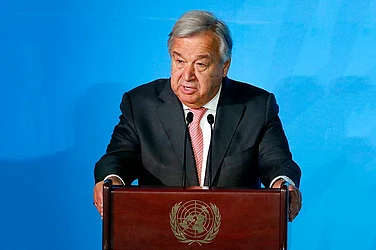At the 27th session of the COP, Mangrove Alliance for Climate (MAC) was launched in partnership with India, to meet the goal towards carbon sinking by restoring mangrove plantations.
The UAE and Indonesia launched the alliance on the sidelines of the UN climate summit COP27, being held in Sharm El Sheikh in Egypt from November 6 to 18. The collaboration aims to strengthen the conservation and restoration of mangrove ecosystems worldwide. India, Australia, Japan, Spain and Sri Lanka have joined it as partners.
India has demonstrated expertise in mangrove restoration for nearly five decades and can contribute to the global knowledge base due to its extensive experience, Union Environment Minister Bhupender Yadav said Monday at the “Mangrove Alliance for Climate” launch.
What is MAC?
MAC is an initiative to educate and spread worldwide awareness on the importance of mangroves and their role in curbing global warming to fight climate change.
UAE’s Minister of Climate Change and the Environment, Mariam bint Mohammed Almheiri, while launching the initiative, said that her country plans to plant over 3 million mangroves over the next two months while pledging to plant 100 million mangroves by 2030.
Taking to Twitter, she said, “At #COP27, we announced the launch of the Mangrove Alliance for Climate (MAC) in partnership with Indonesia 🇮🇩. MAC seeks to scale up and accelerate the conservation and restoration of #mangrove ecosystems for the benefit of communities worldwide.”
According to the Dubai-based news portal, Al Arabiya, she emphasised the need to rely on “nature-based solutions” as an integral element of UAE’s climate action plan.
Creating a new carbon sink from mangrove afforestation and reducing emissions from mangrove deforestation are two feasible ways for countries to meet their Nationally Determined Contribution (NDC) targets and achieve carbon neutrality, leaders noted.
Why are mangroves significant in fighting climate change?
With notable adaptive features, mangroves are the natural armed forces of tropical and subtropical nations. They are the best option to fight against consequences of climate change such as sea level rise and increased frequency of natural calamities like cyclones and storm surges, Yadav said.
“The integration of mangroves into the national programmes for reducing emissions from deforestation and forest degradation is the need of the hour. India can contribute to the global knowledge base due to its extensive experience in mangrove restoration, studies on ecosystem valuation and carbon sequestration,” Yadav said.
“We see the tremendous potential mangroves have for mitigating growing greenhouse gas concentration in the atmosphere. Studies have shown that mangrove forests can absorb four to five times more carbon emissions than landed tropical forests,” Yadav said.
Mangroves are distributed in the tropical and sub-tropical region of the world and are found in 123 countries.
They are among the most carbon-rich forests in the tropics and account for three per cent of carbon sequestered by the world’s tropical forests.
“Mangroves are the economic foundations of many tropical coastal regions. To sustain the blue economy, it is imperative to ensure the sustainability of coastal habitats, particularly mangroves for tropical nations, at the local, regional, and international levels,” Yadav said.
Mangrove trees can grow in saline waters, and can sequester up to four times more carbon than tropical rainforests. Eighty per cent of the global fish populations depend on mangrove ecosystems.
As part of this alliance, an international mangrove research centre will be established in Indonesia which will conduct studies on mangrove ecosystem services such as carbon sequestration and ecotourism.
What has India pledged in MAC?
As part of its NDCs, India has committed to creating an additional carbon sink of 2.5 to 3 billion tonnes of CO2 equivalent through additional forest and tree cover by 2030.
India has demonstrated expertise in mangrove restoration activities for nearly five decades and restored different types of mangrove ecosystems both on its east and west coasts, the union minister noted, adding there has been a significant increase in the mangrove cover in India in the Andaman, Sundarbans and the Gujarat regions.
What is the current state of mangrove forestation?
A net of 5,245 square km of mangrove forest has been lost since 1996, driven by a combination of direct human impacts such as clearance and conversion, but also by harder-to-manage changes driven by erosion, inundation, or storms, notes the annual report of The Global Mangrove Alliance (GMA) titled, ‘The State of The World’s Mangroves 2022’.
The report further added that while average losses over the last decade have fallen to 0.04 per cent per year and there have been considerable gains in river mouths and deltas.
However, there has been an increasing understanding of the importance of mangroves worldwide and preventing just 1 per cent of mangrove loss can prevent two hundred million tons of carbon locked away.
(with PTI inputs)


























